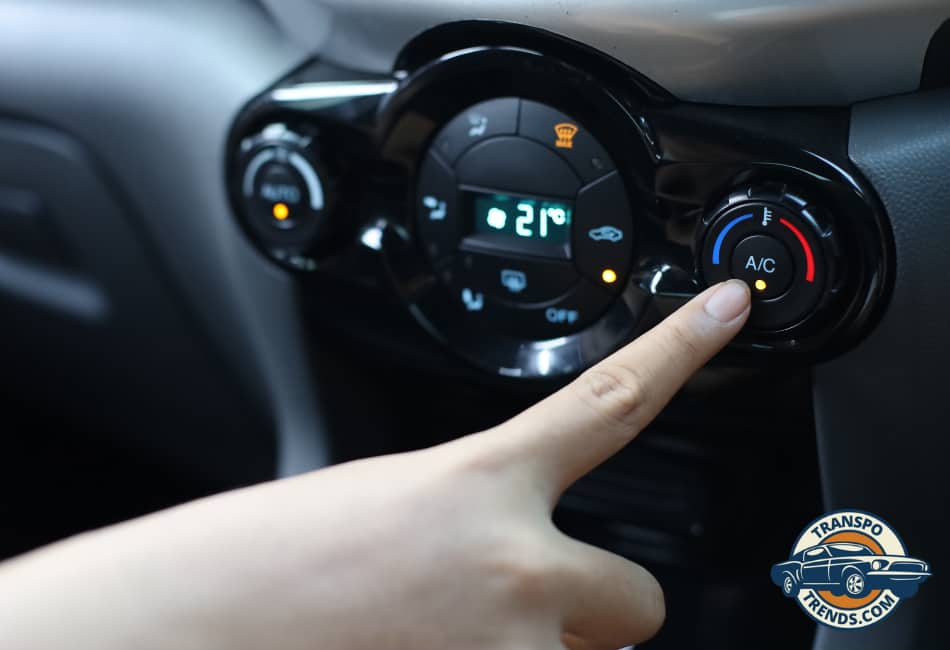Understanding the intricacies of your car’s functioning can go a long way in enhancing your driving experience and ensuring cost efficiency.
One such aspect that often goes unnoticed is the relationship between the speed of your car’s air conditioning (AC) fan and fuel consumption.
This seemingly inconspicuous element can actually have a significant bearing on your vehicle’s fuel efficiency. Being cognizant of this connection helps maintain a comfortable cabin temperature and facilitates potential cost savings.
In this blog post, we will delve into the various ways in which the speed of your AC fan can impact fuel consumption, providing you with insights that could ultimately lead to a more efficient and enjoyable driving experience.
Understanding the Mechanism
Your car’s air conditioning (AC) system is crucial to ensuring your comfort during journeys, particularly in hot weather. The primary elements of this system include the AC compressor, the fan, and the vehicle’s engine.
The AC compressor serves as the heart of the system. It pressurizes and circulates the refrigerant, initiating the cooling process. The fan, on the other hand, aids in distributing the cooled air throughout the vehicle’s cabin.
What’s important to note here is that the AC system draws power directly from the engine. This means that when your AC is running, your engine must work harder, increasing fuel consumption.
The speed of your AC fan plays a significant role in this dynamic. A higher fan speed means the system works harder, drawing more power and consuming more fuel. Conversely, a slower fan speed reduces the load on the engine, potentially leading to more economical fuel consumption.
In the next sections, we will explore these interconnections in more detail, providing you with a comprehensive understanding of how your AC fan speed affects fuel efficiency and how you can optimize your usage for a more cost-effective and comfortable drive.
Factors That Link AC Fan Speed and Fuel Consumption
1. Engine Load
The connection between your AC fan speed and fuel consumption primarily hinges upon the concept of engine load. The engine load refers to the amount of work the engine must perform at a given time.
When the air conditioning system is turned on, the AC compressor, which pressurizes and circulates the refrigerant, places an additional load on the engine.
This added workload is because the engine must now provide power for its standard functions (like propelling the car and charging the battery) and for operating the AC system. The amount of this additional load directly corresponds to the speed of the AC fan.
When you set the AC fan at a higher speed, the compressor must work harder to maintain the desired temperature, thus placing a greater load on the engine.
This harder work translates into higher fuel usage as the engine burns more fuel to cope with the increased demand.
On the other hand, when the AC fan operates at a slower speed, the compressor doesn’t have to exert as much effort, thus reducing the load on the engine and potentially decreasing fuel consumption.
Understanding this relationship can help you optimize your AC usage, potentially saving fuel costs while ensuring a comfortable driving experience.
2. Increased Drag
The ‘ increased drag ‘ is another factor linking AC fan speed and fuel consumption.’ This term refers to the resistance created against the engine’s rotation when the AC system operates.
When you turn on the AC and set the fan to a higher speed, the compressor must work harder to pressurize the refrigerant and circulate it throughout the system. This results in greater resistance or ‘drag’ against the engine’s rotation.
It’s akin to trying to walk through a strong headwind; the harder the wind blows (or the higher the fan speed), the more effort is required to move forward (or to rotate the engine).
This increased effort means the engine has to burn more fuel to maintain the same speed and performance levels.
In simple terms, the harder your AC works, the harder your engine works to maintain the same output, which leads to increased fuel consumption.
By understanding the concept of increased drag, you can better manage your AC settings and strike a balance between maintaining a comfortable cabin temperature and optimizing fuel efficiency.
3. Efficiency of the AC System
A pivotal factor often overlooked in the correlation between AC fan speed and fuel consumption is the air conditioning system’s efficiency. When the AC fan operates at a higher speed, it can disrupt the airflow within the system.
A streamlined, consistent airflow is crucial for the efficient operation of the AC unit. However, when the fan speed is increased, it can cause a disruptive effect, making the air circulate erratically rather than flowing smoothly.
This disruption forces the AC system to work harder to maintain the set temperature inside the vehicle.
Subsequently, the compressor, which plays a key role in the refrigeration cycle of the AC system, would need to operate for extended periods. This longer operation duration can significantly decrease the overall efficiency of the system.
Loss of efficiency in the AC system ultimately results in increased fuel consumption. This is due to the fact that the engine has to compensate for the inefficient AC operations by burning more fuel, thus increasing your vehicle’s fuel consumption.
With this understanding, it becomes clear that the efficiency of the AC system is intrinsically linked to your vehicle’s fuel consumption.
By managing the fan speed to ensure a smoother airflow within the system, you can enhance the overall efficiency of the AC and, in turn, optimize fuel efficiency.
4. Aerodynamic Impact
An often underestimated factor that can significantly influence a vehicle’s fuel consumption is the aerodynamics of the car.
Studies have indicated that higher AC fan speeds can indirectly affect the aerodynamics of a vehicle, leading to higher fuel consumption.
When the AC fan speed is elevated, it can potentially disrupt the airflow within the vehicle. The core principle of aerodynamics emphasizes a smooth and consistent airflow, which ensures the vehicle moves efficiently through the air with minimal resistance.
However, the erratic airflow caused by higher AC fan speeds can create a scenario where the vehicle encounters more air resistance while moving.
This situation is akin to a swimmer swimming against a strong current. It requires greater effort or, in a vehicle’s case, more engine power.
The increased air resistance forces the engine to work harder to maintain the same speed. This hard work translates to a higher fuel requirement, thereby increasing the vehicle’s fuel consumption.
5. Alternator Load
The vehicle’s alternator powers the AC system. The higher the fan speed, the more electricity it consumes; thus, the greater load it places on the alternator.
This increased electrical load can prove to be a burden for small cars with smaller alternators.
Depending on its size and condition, an alternator may be unable to keep up with the high electrical demand of a fan running at higher speeds.
This situation can cause another alternator component to become strained: its voltage regulator. When this happens, it may force the alternator to work harder, requiring more fuel.
Ultimately, increased reliance on the alternator due to a higher AC fan speed translates to higher fuel consumption.
To sum up, running your vehicle’s AC fan at too high a speed can cause the engine to work harder and the alternator to take on more strain, increasing fuel consumption.
Balancing Comfort and Fuel Efficiency
It is crucial to balance maintaining a comfortable temperature within your vehicle and optimizing fuel efficiency.
While it’s understandable to want a cool and comfortable environment inside your vehicle, particularly during hot weather, unnecessary overuse of the AC system can significantly increase fuel consumption.
However, with a few strategic actions, you can enjoy a comfortable driving experience without overly taxing your vehicle’s fuel economy.
Wise use of the AC System
- Setting the Fan Speed Judiciously:
As discussed, the higher the AC fan speed, the more strain it puts on the engine, leading to increased fuel consumption.
Therefore, adjust the fan speed to a level that provides comfort without unnecessarily pushing it to its maximum.
- Using Recirculation Mode:
The AC system’s recirculation mode can be useful for cooling the cabin faster and reducing the system’s workload.
This mode recycles the already cooled air inside the cabin instead of continuously cooling warm air from outside, thereby saving energy and fuel.
- Parking in Shaded Areas:
One simple yet effective way to reduce the initial cooling needs of your vehicle is to park in shaded areas whenever possible. By doing so, you maintain a relatively lower temperature within your vehicle, thereby reducing the amount of work the AC system needs to do to cool it down.
Conclusion
In conclusion, it’s important to remember the various aspects we’ve discussed throughout this blog post regarding managing your vehicle’s temperature and optimizing fuel efficiency.
We’ve learned that the speed of the AC fan does indeed impact fuel consumption, but it’s crucial to note that this might not drastically affect your vehicle’s fuel economy in all situations.
Striking the right balance between comfort and efficiency is key. Opting for a judicious fan speed, using the recirculation mode, and choosing shaded areas for parking are all strategies that can help you achieve this balance.
Each action, though simple, contributes to reducing the workload of the AC system and thereby enhances fuel efficiency.
However, the choice ultimately depends on your specific driving conditions, the efficiency of your vehicle, and your personal comfort preferences.
While we can provide guidelines and insights on how to maximize fuel efficiency, it’s essential for you to assess and make a decision based on your unique circumstances and needs.
By being mindful and taking control of your vehicle’s AC use, you can enjoy a comfortable driving experience while optimizing fuel consumption.

